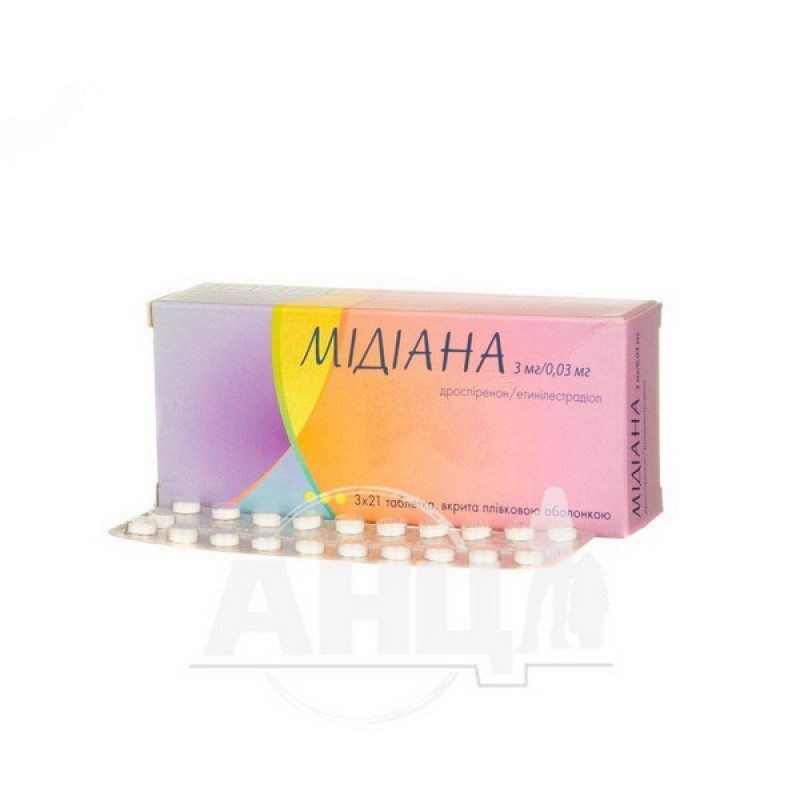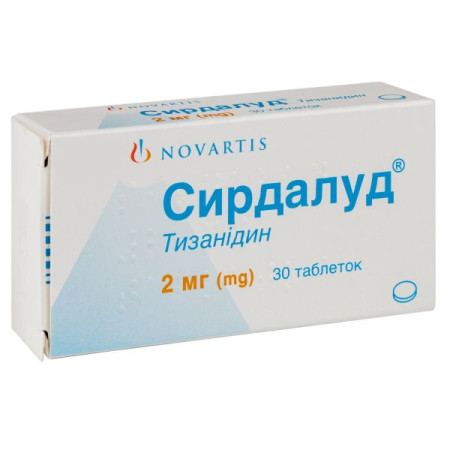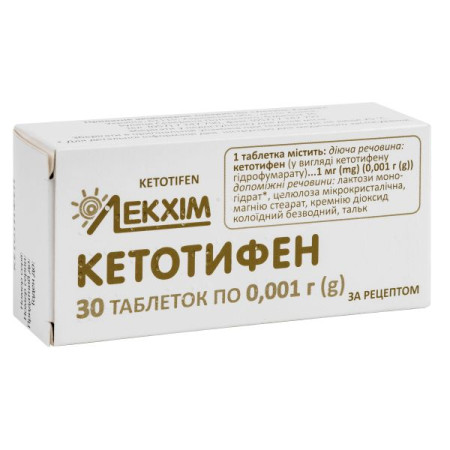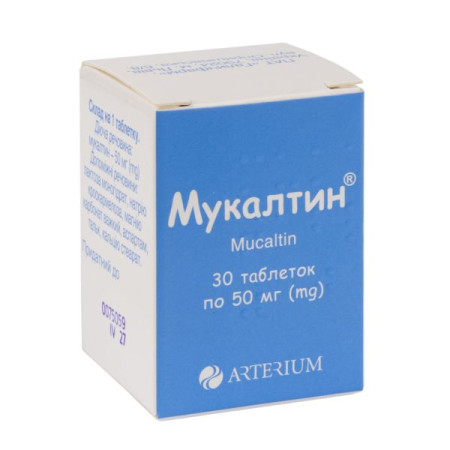Midiana film-coated tablets blister No. 63
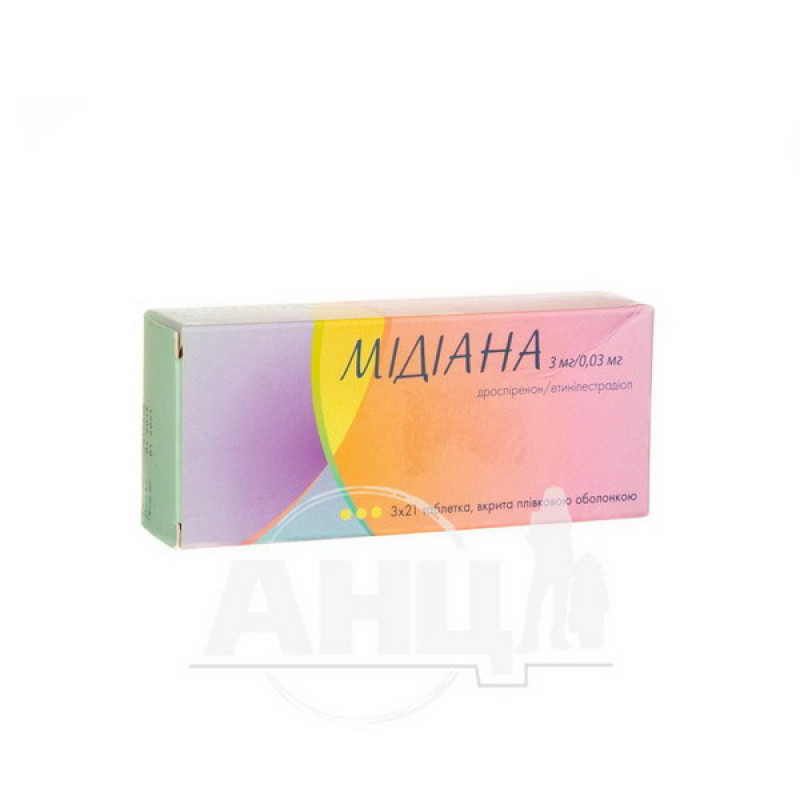
Instructions for use Midiana film-coated tablets blister pack No. 63
Composition
active ingredients: drospirenone, ethinylestradiol;
1 tablet contains drospirenone 3 mg, ethinyl estradiol 0.03 mg;
excipients: lactose monohydrate, corn starch, pregelatinized starch, povidone K 25, magnesium stearate;
shell: Opadry II white (polyvinyl alcohol, titanium dioxide (E 171), macrogol, talc, lecithin (soy)).
Dosage form
Film-coated tablets.
Main physicochemical properties: white or almost white, round, biconvex, film-coated tablets, engraved with “G63” on one side, plain on the other. Diameter – approximately 6 mm.
Pharmacotherapeutic group
Sex gland hormones and drugs used in genital pathology. Hormonal contraceptives for systemic use.
ATX code G0ЗА A12.
Pharmacological properties
Pharmacodynamics.
The contraceptive effect of Midiana tablets is based on the interaction of various factors, the most important of which are inhibition of ovulation and changes in the endometrium.
Midiana, film-coated tablets, is a combined oral contraceptive containing ethinylestradiol and the progestogen drospirenone. In therapeutic doses, drospirenone also has antiandrogenic and mild antimineralocorticoid properties. It is devoid of any estrogenic, glucocorticoid and antiglucocorticoid activity. This provides drospirenone with a pharmacological profile very similar to the natural hormone progesterone.
The mild antimineralocorticoid properties of Midiana tablets result in a mild antimineralocorticoid effect.
The Pearl contraceptive failure index for the drug is 0.09 (upper two-sided 95% confidence interval (CI) 0.32).
The overall Pearl Index (contraceptive failures + patient errors) for the drug is 0.57 (upper two-sided 95% CI – 0.90).
Pharmacokinetics.
Drospirenone
Absorption
When taken orally, drospirenone is rapidly and almost completely absorbed. The maximum concentration of the active substance in the blood serum, equal to 38 ng/ml, is reached 1-2 hours after a single dose. The bioavailability of drospirenone ranges from 76% to 85%. Simultaneous food intake does not affect the bioavailability of drospirenone.
Distribution
After oral administration, there is a decrease in serum levels of drospirenone, characterized by a half-life of 31 hours. Drospirenone binds to serum albumin and does not bind to sex hormone binding globulin (SHBG) or corticosteroid binding globulin (CBG).
Only 3-5% of the total serum concentration of the active substance is free hormone. The ethinylestradiol-induced increase in GSH does not affect the binding of drospirenone to serum proteins. The average apparent volume of distribution is 3.7±1.2 l/kg.
Biotransformation
After oral administration, drospirenone is extensively metabolized. The majority of metabolites in plasma are represented by acid forms of drospirenone, obtained by opening the lactone ring, and 4,5-dihydro-drospirenone-3-sulfate, formed by reduction and subsequent sulfation. Drospirenone is also subject to oxidative metabolism, catalyzed by CYP3A4. In vitro, the drug has been shown to inhibit the activity of this isoenzyme, as well as isoenzymes of the cytochrome P450 system 1A1, 2C9 and 2C19.
Breeding
The metabolic clearance rate of drospirenone in serum is 1.5±0.2 ml/min/kg. Drospirenone is excreted only in trace amounts unchanged. The metabolites of drospirenone are excreted in the feces and urine in a ratio of approximately 1.2:1.4. The half-life for the excretion of metabolites in urine and feces is approximately 40 hours.
Equilibrium concentration
During one treatment cycle, the maximum steady-state concentration of drospirenone in serum (approximately 70 ng/ml) is reached after 8 days of use. The serum concentration of drospirenone increases approximately 3-fold due to the existing relationship between the terminal half-life and the dosing interval used.
Ethinylestradiol
Absorption
Ethinylestradiol is rapidly and completely absorbed after oral administration. The maximum serum concentration after a single oral dose is reached after 1-2 hours and is approximately 33 pg/ml. Absolute bioavailability as a result of presystemic conjugation and the effect of the first pass through the liver is approximately 60%. Simultaneous food intake reduced the bioavailability of ethinylestradiol by approximately 25% in the women studied, while no changes were observed in the others.
Distribution
After oral administration, there is a biphasic decline in serum ethinylestradiol levels, characterized by a half-life of approximately 24 hours. Ethinylestradiol is highly but non-specifically bound to plasma proteins (approximately 98.5%) and induces an increase in serum levels of GH and CSH. The estimated volume of distribution of ethinylestradiol is approximately 5 l/kg.
Ethinylestradiol undergoes extensive intestinal metabolism and first-pass metabolism in the liver. Ethinylestradiol is metabolized primarily by aromatic hydroxylation, but a wide range of hydroxyl and methyl metabolites are formed, which are present as free metabolites and conjugates with glucuronides and sulfates. The metabolic clearance rate of ethinylestradiol is approximately 5 ml/min/kg. In vitro, ethinylestradiol is a reversible inhibitor of CYP2C19, CYP1A1 and CYP1A2, and an inhibitor of CYP3A4/5, CYP2C8 and CYP2J2.
Breeding
Ethinylestradiol is almost not excreted unchanged. Metabolites of ethinylestradiol are excreted in urine and bile in a ratio of 4:6. The half-life for metabolites is approximately 1 day.
Equilibrium concentration
Steady-state concentration is reached during the second half of the treatment cycle, with serum ethinylestradiol levels accumulating by a factor of approximately 1.4-2.1.
Certain categories of the population
Effects on kidney function
Steady-state serum levels of drospirenone in women with mild renal impairment (creatinine clearance 50-80 ml/min) were comparable to those in women with normal renal function (> 80 ml/min). Serum levels of drospirenone were on average 37% higher in women with moderate renal impairment (CLcr = 30-50 ml/min) compared to those in women with normal renal function. Treatment with drospirenone was well tolerated in women with both mild and moderate renal impairment.
Treatment with drospirenone had no clinically significant effect on serum potassium concentrations.
Effects on liver function
Oral clearance in volunteers with moderate hepatic impairment was approximately 50% reduced compared to subjects with normal hepatic function.
This decrease in drospirenone clearance in volunteers with moderate renal impairment does not lead to any significant differences in serum potassium concentrations.
Even with diabetes and concomitant treatment with spironolactone (two factors that can provoke hyperkalemia in the patient), there was no increase in serum potassium concentration above the upper limit of normal.
It can be concluded that the combination of drospirenone/ethinyl estradiol is well tolerated in patients with moderate hepatic impairment (Child-Pugh class B).
Ethnic groups
No clinically significant differences in the pharmacokinetics of drospirenone or ethinylestradiol were observed between women of European and Asian races.
Indication
Oral contraception.
Contraindication
Combined oral contraceptives (COCs) should not be used if any of the following conditions are present. If any of these conditions appear for the first time during COC use, the drug should be stopped immediately:
hypersensitivity to the active substances or to any of the excipients of the medicinal product (see section "Composition");
hypersensitivity to peanuts or soy;
Presence or risk of venous thromboembolism (VTE):
Venous thromboembolism – current VTE, particularly due to anticoagulant therapy or a history (e.g. deep vein thrombosis (DVT) or pulmonary embolism (PE));
known hereditary or acquired predisposition to venous thromboembolism, such as resistance to activated protein C (including factor V Leiden mutation), antithrombin III deficiency, protein C deficiency, protein S deficiency;
major surgery with prolonged immobilization (see section "Special instructions for use");
high risk of venous thromboembolism due to the presence of multiple risk factors (see section "Special warnings and precautions for use");
presence or risk of arterial thromboembolism (ATE):
arterial thromboembolism – the presence of arterial thromboembolism at present or in history (for example, myocardial infarction) or a prodromal state (for example, angina pectoris);
cerebrovascular disease – current or past stroke, presence of a prodromal condition (e.g., transient ischemic attack (TIA));
known hereditary or acquired predisposition to the development of arterial thromboembolism, such as hyperhomocysteinemia and the presence of antiphospholipid antibodies (anticardiolipin antibodies, lupus anticoagulant);
migraine with focal neurological symptoms in history;
high risk of arterial thromboembolism due to the presence of multiple risk factors (see section "Special warnings and precautions for use") or due to the presence of one of the following serious risk factors:
diabetes mellitus with vascular complications;
severe arterial hypertension;
severe dyslipoproteinemia;
the presence of severe liver disease at present or in history, until liver function tests have returned to normal;
severe renal failure or acute renal failure;
the presence of liver tumors at present or in history (benign or malignant);
known or suspected malignant tumors (e.g., genital or breast) that are sex hormone-dependent;
vaginal bleeding of unknown etiology;
The simultaneous use of the drug Midiana with drugs containing ombitasvir/paritaprevir/ritonavir, dasabuvir, glecaprevir/pibrentasvir and sofosbuvir/velpatasvir/voxilaprevir is contraindicated (see sections “Interaction with other medicinal products and other types of interactions” and “Special instructions for use”).
Interaction with other medicinal products and other types of interactions
The information for the concomitant medicinal product should be consulted to identify potential interactions.
Pharmacodynamic interactions
Concomitant use with medicinal products containing ombitasvir/paritaprevir/ritonavir and dasabuvir, with or without ribavirin, glecaprevir/pibrentasvir and sofosbuvir/velpatasvir/voxilaprevir may increase the risk of alanine aminotransferase (ALT) elevations (see sections 4.3 and 4.4). Therefore, before starting these medicinal products, patients taking Midiana should switch to an alternative method of contraception (e.g. progestogen-only contraception or non-hormonal methods). Midiana may be restarted 2 weeks after completing treatment with these medicinal products.
Pharmacokinetic interactions
The effect of other medicines on Midiana
Interactions are possible with drugs that induce microsomal enzymes. This may lead to increased clearance of sex hormones, which in turn may cause breakthrough bleeding and/or loss of contraceptive efficacy.
Therapy
Enzyme induction can be detected after a few days of treatment. Maximum enzyme induction is generally measured after a few weeks. After discontinuation of treatment, enzyme induction may persist for approximately 4 weeks.
Short-term treatment
Women taking enzyme-inducing drugs should temporarily use a barrier method or another method of contraception in addition to the COC. The barrier method should be used throughout the entire period of treatment with the drug and for 28 days after stopping its use. If therapy is started during the last COC tablet-free period, the next COC tablet-free period should be started immediately after the previous one without the usual tablet-free interval.
Long-term treatment
For women on long-term therapy with active substances that induce liver enzymes, a barrier or other appropriate non-hormonal method of contraception is recommended.
The following interactions have been reported based on published data.
Active substances that increase COC clearance (reduced COC efficacy due to enzyme induction), for example:
Barbiturates, bosentan, carbamazepine, phenytoin, primidone, rifampicin; medicines used for HIV infection: ritonavir, nevirapine and efavirenz; also possibly felbamate, griseofulvin, oxcarbazepine, topiramate and medicines containing the herbal medicine St. John's wort (Hypericum perforatum).
Substances with inconsistent effects on PDA clearance
When used concomitantly with COCs, a large number of combinations of HIV protease inhibitors and non-nucleoside reverse transcriptase inhibitors, including combinations with hepatitis C virus (HCV) inhibitors, may increase or decrease plasma concentrations of estrogen or progestins. The cumulative effect of such changes may be clinically significant in some cases.
Therefore, the prescribing information for the concomitant HIV/HCV medicinal product should be consulted for potential interactions and any other recommendations. In case of any doubt, women should additionally use a barrier method of contraception during treatment with protease inhibitors or non-nucleoside reverse transcriptase inhibitors.
Active substances that reduce the clearance of PDA (enzyme inhibitors)
The clinical significance of the potential interaction with enzyme inhibitors remains unknown.
Concomitant use of strong CYP3A4 inhibitors may increase plasma concentrations of estrogen or progestin, or both.
In a multiple-dose study of the combination of drospirenone (3 mg/day)/ethinyl estradiol (0.02 mg/day) and the strong CYP3A4 inhibitor ketoconazole for 10 days, the AUC(0-24 h) of drospirenone and ethinyl estradiol increased 2.7- and 1.4-fold, respectively.
Etoricoxib at doses of 60 mg/day to 120 mg/day has been shown to increase plasma concentrations of ethinyl estradiol by 1.4- to 1.6-fold, respectively, when co-administered with a combined hormonal contraceptive containing 0.035 mg ethinyl estradiol.
The effect of Midiana on other medicines
Combined oral contraceptives may affect the metabolism of other drugs. As a result, the concentration of active substances in the blood plasma and tissues may change - either increase (e.g., cyclosporine) or decrease (e.g., lamotrigine).
Clinical data suggest that ethinylestradiol inhibits the clearance of CYP1A2 substrates, which in turn causes a slight (e.g. theophylline) or moderate (e.g. tizanidine) increase in their plasma concentrations.
Other forms of interaction
In patients with normal renal function, concomitant use of drospirenone and ACE inhibitors or nonsteroidal anti-inflammatory drugs (NSAIDs) has not shown a significant effect on serum potassium levels. However, concomitant use of aldosterone antagonists or potassium-sparing diuretics has not been studied. In this case, serum potassium levels should be monitored during the first cycle of treatment (see also section 4.4).
Laboratory studies
The use of contraceptive steroids may affect the results of some laboratory tests, such as biochemical indicators of liver, thyroid, adrenal and renal function, as well as the level of plasma transport proteins such as corticosteroid-binding globulin and lipid/lipoprotein fractions, indicators of carbohydrate metabolism, coagulation and fibrinolysis. Changes are usually within normal limits.
Drospirenone increases plasma renin and aldosterone activity, which is due to its mild antimineralocorticoid activity.
Application features
The decision to prescribe Midiana should take into account the woman's current individual risk factors, including risk factors for venous thromboembolism (VTE), and the risk of VTE associated with Midiana compared with other combined hormonal contraceptives (CHCs) (see sections "Contraindications" and "Special Instructions").
Warning
If any of the conditions or risk factors listed below are present, the appropriateness of using Midiana should be discussed with the woman.
In the event of exacerbation or at the first manifestations of any of the above conditions or risk factors, women are advised to consult a doctor and determine the need to discontinue taking Midiana.
In case of suspected or confirmed arterial or venous thrombosis, CHC use should be discontinued. If anticoagulant therapy is initiated, alternative adequate contraception should be provided due to the teratogenic effects of anticoagulants (coumarins).
Circulatory disorders
Risk of venous thromboembolism (VTE)
The risk of venous thromboembolism (VTE) is increased with any CHC compared with no use. Use of products containing levonorgestrel, norgestimate or norethisterone is associated with a lower risk of VTE. Use of other drugs such as Midiana may lead to a twofold increase in risk. The decision to use a drug that does not belong to the group of drugs with the lowest risk of VTE should be made only after discussion with the woman. It is necessary to ensure that she is aware of the risk of VTE associated with the use of Midiana, the extent to which her existing risk factors affect the level of the above risk and the fact that the risk of VTE is highest during the first year of use of the drug. According to some data, the risk of VTE may increase when resuming CHC use after a break of 4 weeks or more.
Among women who do not use CHCs and are not pregnant, the incidence of VTE is approximately 2 cases per 10,000 women per year. However, the risk for any individual woman may be much higher, depending on the underlying risk factors she has (see below).
It has been estimated1 that out of 10,000 women using CHCs containing drospirenone, 9-12 will develop VTE in one year. This compares with around 62 in women using CHCs containing levonorgestrel.
In both cases, the number of VTE cases per year was lower than would normally be expected during pregnancy or in the postpartum period.
VTE can lead to fatal outcomes in 1-2% of cases.
Number of VTE cases per 10,000 women in one year
1 These figures are based on all epidemiological data, taking into account the relative risks associated with the use of different CHCs compared with the use of CHCs containing levonorgestrel.
2 On average 5-7 cases per 10,000 women-years based on the calculation of the relative risk of using levonorgestrel-containing CHCs compared to that in women not using CHCs (approximately 2.3 - 3.6 cases).
Thrombosis in other blood vessels, such as the arteries and veins of the liver, kidneys, retina or mesenteric vessels, has been reported extremely rarely in women using CHCs.
Risk factors for developing VTE
Midiana is contraindicated in women with multiple risk factors that place them at high risk of developing venous thrombosis (see section 4.3). If a woman has more than one risk factor, the increased risk may be greater than the sum of the risks associated with each individual factor, so the overall risk of VTE should be considered. CHCs should not be used if the benefit/risk ratio is unfavourable (see section 4.3).
Table 1
Risk factors for developing VTE
| Risk factor | Note |
Obesity (body mass index more than 30 kg/m2). | The risk increases significantly with increasing body mass index. It especially requires attention if women have other risk factors. |
Prolonged immobilization (including air travel of more than 4 hours), major surgery, any surgery on the legs or pelvic organs, neurosurgery, or extensive trauma. Note: Temporary mobilization, including air travel of more than 4 hours, may also be a risk factor for VTE, especially for women with other risk factors. | In such cases, it is recommended to stop taking the tablets (in the case of elective surgery at least 4 weeks in advance) and not to resume use earlier than 2 weeks after full recovery of motor activity. To avoid unexpected pregnancy, another method of contraception should be used. The feasibility of antithrombotic therapy should be considered if Midiana has not been discontinued in advance. |
| Family history (venous thromboembolism in a sibling or parent, especially at a relatively young age, such as under 50 years of age). | In case of hereditary predisposition, women are advised to consult a specialist before using any CHC. |
| Other conditions associated with VTE | Cancer, systemic lupus erythematosus, hemolytic uremic syndrome, chronic inflammatory bowel disease (Crohn's disease or ulcerative colitis), and sickle cell anemia. |
| Increasing age | Especially over 35 years old. |
There is no consensus on the possible impact of varicose veins and superficial thrombophlebitis on the development or progression of venous thrombosis.
Attention should be paid to the increased risk of thromboembolism during pregnancy, especially during the first 6 weeks after delivery (see section "Use during pregnancy or breastfeeding").
Symptoms of VTE (deep vein thrombosis and pulmonary embolism)
If the following symptoms occur, a woman should seek urgent medical attention and inform the doctor that she is taking CHCs.
Symptoms of deep vein thrombosis (DVT) may include:
unilateral swelling of the leg and/or foot or an area along a vein on the leg;
pain or increased sensitivity in the leg that may only be felt when standing or walking;
a feeling of heat in the affected leg; redness or discoloration of the skin on the leg.
Symptoms of pulmonary embolism (PE) may include:
sudden shortness of breath of unknown etiology or rapid breathing;
sudden onset of coughing, which may be accompanied by hemoptysis;
sudden chest pain;
fainting or dizziness;
fast or irregular heartbeat.
Some of these symptoms (e.g., shortness of breath, cough) are nonspecific and may be misdiagnosed as more common or less severe conditions (e.g., respiratory tract infections).
Other signs of vascular occlusion may include sudden pain, swelling, and slight blueness of the limb.
In the case of occlusion of the vessels of the eye, the initial symptom may be blurred vision, which is not accompanied by pain, and which can progress to loss of vision. Sometimes the loss of vision develops almost instantly.
Risk of arterial thromboembolism (ATE)
Epidemiological studies have shown that the use of any CHC is associated with an increased risk of arterial thromboembolism (myocardial infarction) or cerebrovascular events (e.g. transient ischemic attack, stroke). Arterial thromboembolic events can be fatal.
Risk factors for developing ATE
The risk of arterial thromboembolic complications or cerebrovascular events increases with the use of CHCs in women with risk factors (see Table 2). Midiana is contraindicated if a woman has one serious or multiple risk factors for ATE that may increase the risk of arterial thrombosis (see section "Contraindications"). If a woman has more than one risk factor, the increased risk may be greater than the sum of the risks associated with each individual factor, so the overall risk of ATE should be taken into account. CHCs should not be prescribed if the benefit/risk ratio is unfavorable (see section "Contraindications").
Table 2
Risk factors for developing ATE
| Risk factor | Note |
| Increasing age | Especially over 35 years old. |
| Smoking | Women who wish to use CHCs should be advised to quit smoking. Women over the age of 35 who continue to smoke should be strongly advised to use another method of contraception. | Arterial hypertension |
Obesity (body mass index more than 30 kg/m2) | The risk increases significantly with increasing body mass index. It especially requires attention if women have other risk factors. |
| Family history (arterial thromboembolism in a sibling or parent, especially at a relatively young age, such as under 50 years of age). | In case of hereditary predisposition, women are advised to consult a specialist before using any CHC. |
| Migraine | An increase in the frequency or severity of migraine during CHC use (which may be a prodromal condition before the development of cerebrovascular events) may be a reason for immediate discontinuation of CHC use. |
| Other conditions associated with adverse vascular reactions | Diabetes mellitus, hyperhomocysteinemia, heart valve defects, atrial fibrillation, dyslipoproteinemia, and systemic lupus erythematosus. |
Symptoms of ATE
If the following symptoms occur, a woman should seek urgent medical attention and inform the doctor that she is taking CHCs.
Symptoms of a cerebrovascular accident may include:
sudden numbness or weakness of the face, arms, or legs, especially on one side;
sudden gait disturbance, dizziness, loss of balance or coordination;
sudden confusion, impaired speech or understanding;
sudden vision loss in one or both eyes;
sudden severe or prolonged headache with no known cause;
loss of consciousness or fainting with or without seizures.
The temporary nature of the symptoms may indicate a transient ischemic attack (TIA).
Symptoms of myocardial infarction (MI) may include:
pain, discomfort, pressure, heaviness, a feeling of squeezing or fullness in the chest, arm, or behind the breastbone;
discomfort with irradiation to the back, jaw, throat, arm, stomach;
feeling of fullness in the stomach, indigestion or heartburn;
increased sweating, nausea, vomiting, or dizziness;
extreme weakness, restlessness, or shortness of breath;
fast or irregular heartbeat.
Tumors
The results of some epidemiological studies indicate an additional increase in the risk of developing cervical cancer with long-term use of COCs (> 5 years), but this statement remains controversial, since it is not yet clear to what extent the results of the studies take into account concomitant risk factors, such as sexual behavior and other factors, such as infection with the human papillomavirus (HPV).
A meta-analysis of 54 epidemiological studies has shown a slightly increased relative risk (RR=1.24) of developing breast cancer in women who use COCs. This increased risk gradually disappears within 10 years after stopping COC use. Since breast cancer is rare in women under 40 years of age, the increase in the number of cases diagnosed with breast cancer in women who are currently or have recently used COCs is insignificant in relation to the overall risk of breast cancer. The results of these studies do not provide evidence of a causal relationship. The increased risk may be due to earlier diagnosis of breast cancer in women who use COCs, the biological action of COCs, or a combination of both. There is a tendency for breast cancer detected in women who have ever used COCs to be clinically less severe than in those who have never used COCs.
In isolated cases, benign, and less frequently malignant liver tumors have been observed in women using COCs. In some cases, these tumors have caused life-threatening intra-abdominal bleeding. In the event of complaints of severe epigastric pain, liver enlargement, or signs of intra-abdominal bleeding, the possibility of a liver tumor in women using COCs should be considered in the differential diagnosis.
High-dose COCs (50 mcg ethinylestradiol) reduce the risk of endometrial and ovarian cancer. It remains to be confirmed whether these findings can also be applied to low-dose COCs.
Malignant tumors can be life-threatening or fatal.
Other states
The progestogen component of Midiana is an aldosterone antagonist with potassium-sparing properties. In most cases of use, an increase in serum potassium is not expected. However, in a clinical study, in some patients with mild to moderate renal impairment and concomitant use of potassium-sparing drugs, serum potassium levels increased slightly, but not significantly, during the use of drospirenone. Therefore, it is recommended to monitor serum potassium levels in the first cycle of treatment in patients with renal insufficiency and to maintain serum potassium levels not above the upper limit of normal before starting treatment, especially when potassium-sparing drugs are used simultaneously (see section "Interaction with other medicinal products and other forms of interaction").
Women with hypertriglyceridemia or a family history of this disorder are at risk of developing pancreatitis when using COCs.
Although a slight increase in blood pressure has been described in many women taking COCs, a clinically significant increase in blood pressure is rare. Only in these rare cases does immediate discontinuation of COC use become necessary. In the case of pre-existing hypertension or if blood pressure cannot be adequately controlled with antihypertensive drugs, women taking COCs should discontinue their use. If appropriate, COC use can be resumed after normotensive status has been achieved with antihypertensive therapy.
The following conditions have been reported to occur or worsen during pregnancy and COC use, but the relationship to COC use is not conclusive: jaundice and/or pruritus associated with cholestasis; gallstone formation; porphyria; systemic lupus erythematosus; haemolytic uraemic syndrome; Sydenham's chorea; herpes gestationis; hearing loss associated with otosclerosis.
Exogenous estrogens may induce or exacerbate symptoms of hereditary and acquired angioedema.
Acute or chronic liver function disorders may require discontinuation of COC use until liver function tests return to normal. In the event of recurrence of cholestatic jaundice and/or pruritus caused by cholestasis, which previously occurred during pregnancy or previous use of sex hormones, COC use should be discontinued.
Although combined hormonal contraceptives may affect peripheral insulin resistance and glucose tolerance, there is no evidence that a change in the therapeutic regimen is necessary in diabetic women taking low-dose COCs (containing < 0.05 mg ethinylestradiol). However, women with diabetes should be closely monitored during COC use, especially at the beginning of treatment.
Cases of exacerbation of endogenous depression, epilepsy, Crohn's disease and ulcerative colitis have also been observed during the use of COCs.
Chloasma may occasionally occur, especially in women with a history of chloasma during pregnancy. Women prone to chloasma should avoid exposure to direct sunlight or ultraviolet radiation while taking COCs.
Excipients
This medicinal product contains 48.17 mg of lactose monohydrate per tablet.
Patients with rare hereditary problems of galactose intolerance, the Lapp lactase deficiency or glucose-galactose malabsorption should not take this medicine.
One tablet of this medicine contains 0.07 mg of soy lecithin. This medicine should not be taken by patients with hypersensitivity to peanut or soy.
Medical examination/consultation
Before initiating or reinstituting Midiana, a complete medical history (including family history) and physical examination are recommended, and pregnancy should be ruled out. Blood pressure should be measured and an objective examination should be performed, taking into account the contraindications (see section 4.3) and precautions (see section 4.4). It is important to draw women's attention to the risk of venous and arterial thrombosis, including the risk of Midiana compared with other CHCs, with regard to symptoms of
There are no reviews for this product.
There are no reviews for this product, be the first to leave your review.
No questions about this product, be the first and ask your question.






